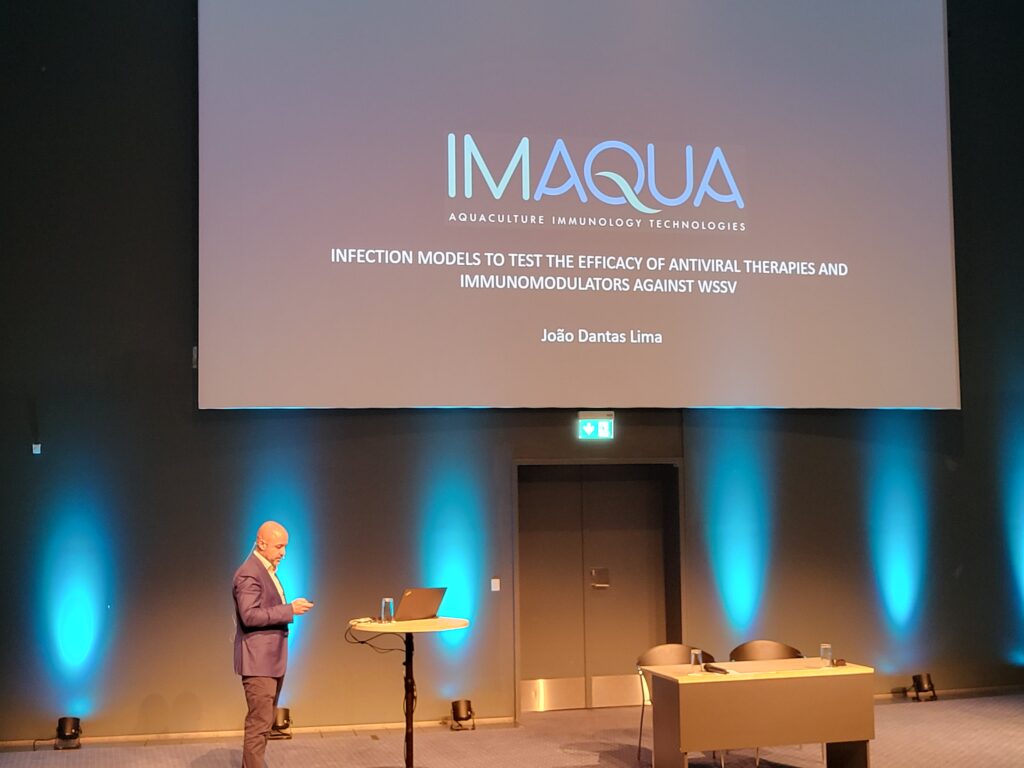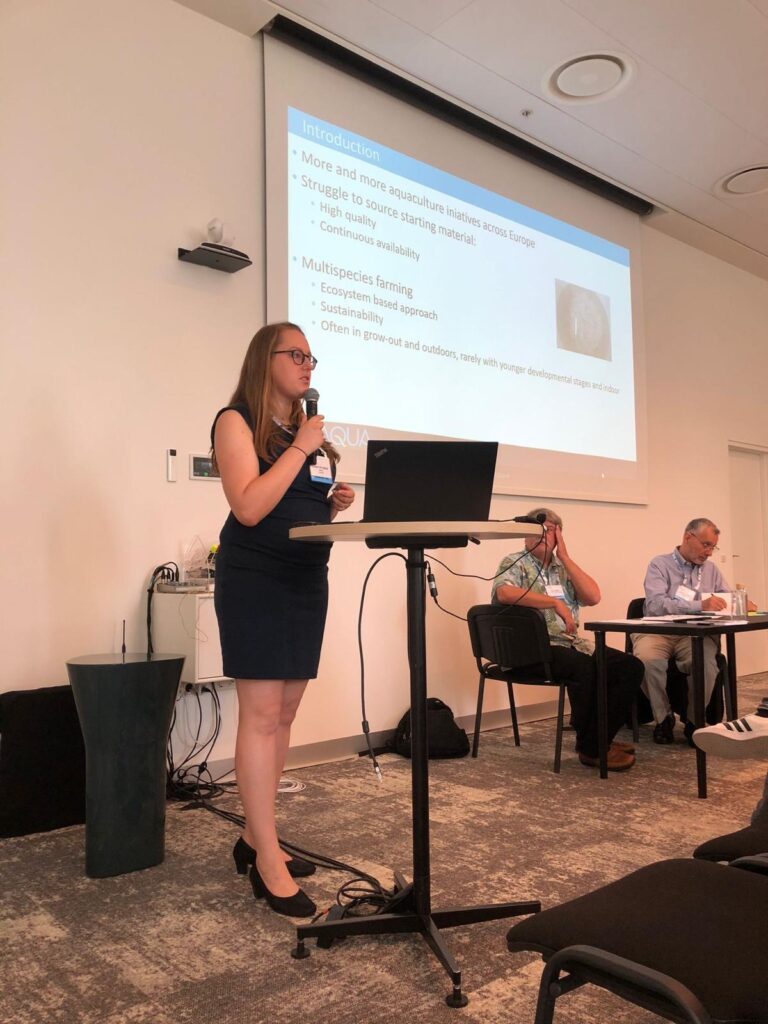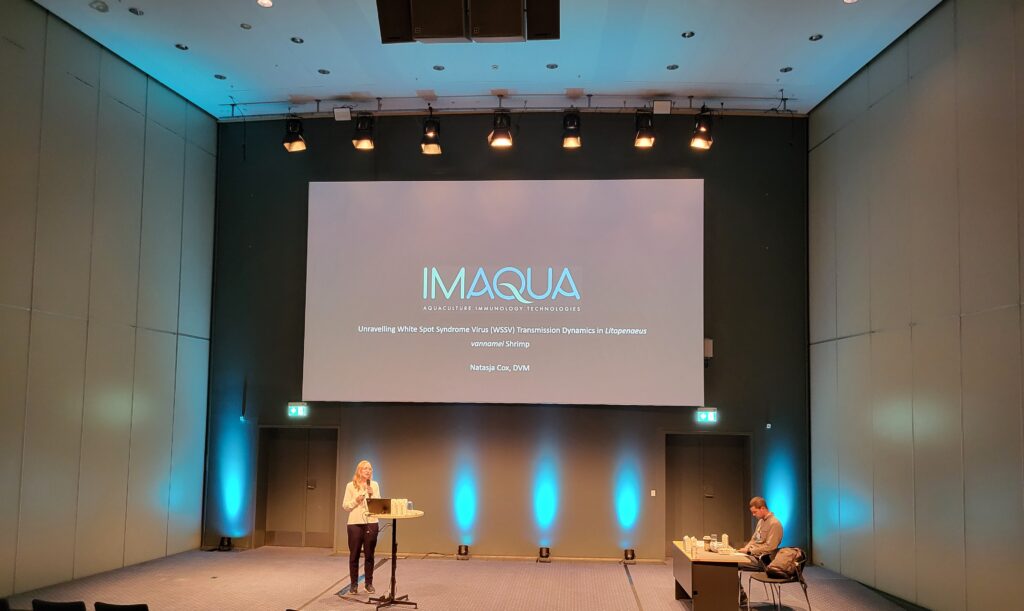At Copenhagen, European Aquaculture 2024 we presented several research updates of crucial Shrimp health topics. If you haven’t a chance to attend live presentations, here you can read the abstracts.
João Dantas Lima presentation focused on “Infection models to test the efficacy of antiviral therapies and immunomodulators against WSSV”.
In vivo white spot syndrome virus (WSSV) infection models are indispensable tools to support the development of antiviral therapies and immunomodulators against white spot disease (WSD). Still, the selection of the most appropriate models for anti-WSSV product development is typically not straightforward. The objective of this review was to further elaborate on this subject to provide investigators with solid arguments for or against the selection of certain types of WSSV infection models in specific research contexts.
A review was conducted by retrieving literature from searches of computerized databases, hand searches, and authoritative texts with the overarching purpose to synthesize the existing literature in the field (Sargeant & O’Connor, 2020).
To determine if anti-WSSV product candidates have virucidal properties, it is advisable to carry out in vivo antiviral activity tests. Multiple product candidates can be screened in parallel, which reduces the costs and the time spend in development. Since, immunomodulators target the host rather than the virus, antiviral activity testing is not applicable. Both for antiviral and immunomodulators product candidates, it is recommended to test in vivo if the chosen delivery method manages to deliver a sufficient concentration of the active substance to intended site(s) of action. Next, the efficacy of the product candidate can be tested during in vivo infection experiments. An inoculation procedure that resembles natural infection (immersion, feeding of WSSV-infected tissues) is expected to help translate study results to the field. Housing shrimp individually instead of in groups when the delivery methods and the efficacy of the therapy still need to be established, is advised, because individuals can easily be monitored and sampled. The evaluation of the product candidate’s protective properties against WSSV can be based on clinical observations (survival rates and pathogen counts), or additional health parameters that can be evaluated through the model and/or additional laboratory tests. At a later development stage, it is more beneficial for the extrapolation of the results to house shrimp in groups instead of individually. This facilitates natural transmission between hosts, which mimics the situation in the field, but in a laboratory setting the biotic and abiotic parameters can still be controlled. It is therefore recommended to test the product candidates in these controlled conditions, before proceeding to assess their effectiveness under ‘real-world’ conditions in field studies on farms.
Natasja Cox1,2, Evelien De Swaef1, Mathias Corteel1, Wim Van Den Broeck4, Peter Bossier3, Hans J. Nauwynck2, João J. Dantas-Lima1*

Evelien De Swaef presented the findings of the research project BLEUMARINE3.COM from 4 research groups of Ghent university and 6 industry partners during her presentation “Tackling the shrimp hatchery bottlenecks for European shrimp aquaculture and assessing the development of a multispecies hatchery in Europe”.
There is a growing interest in the development of local aquaculture production throughout Europe. Many initiatives exist, such as indoor penaeid shrimp farming, bivalve and seaweed culture, or restauration of the flat oyster (Ostrea edulis) reefs in the North Sea. However, one of the common problems across many initiatives is the struggle to source high quality and continuously available starting material, pathogen free and with a suitable genetic background. During the BlueMarine3.com project, the expertise of Ghent University and six Flemish companies was joined to tackle the challenges related to sourcing material. For this, hatchery protocols for shrimp, bivalves and seaweeds were adapted to the local conditions, keeping in mind economic feasibility and sustainability for the environment. The aim of the project was not only to develop a compact, closed recirculation system for larval production on land considering the high costs for land, labor and energy in Europe; but also to study and to value the synergy between hatchery techniques for the different species in terms of infrastructure, resources, breeding and management (i.e. a multispecies hatchery concept).
For shrimp (Litopenaeus vannamei) larval rearing, IMAQUA joined forces with the Ghent University and Proviron to tackle the current bottlenecks. During the project, broodstock diet composition and feeding schedules were optimized. The project revealed that lowering the water temperature by 3°C during the maturation of the broodstock animals, had no impact on the breeding success of the animals (up till PL1), increasing the economic feasibility of the shrimp hatchery in the European temperate climate. At the level of the larval rearing, several larval diet formulations were finetuned, ensuring high-quality postlarvae through the use of (live) microalgae. Within the project, also several seawater sources were compared, indicating that both natural and artificial seawater can be used to perform high-quality shrimp breeding and production, although the sea salt mixture source must be carefully chosen. The successful cultivation of L. vannamei under conditions more suitable for European realities laid the foundation for the successful development of the European shrimp farming industry. Additionally, this increases the possibility of incorporating L. vannamei into multispecies recirculating systems with colder water species.
Evelien De Swaef1*, Luc Roef, Peter Bossier, João J. Dantas-Lima1
This research received funding from Flanders Innovation and Entrepreneurship (Belgium).

Natasja Cox has made two presentations. The first one focused on “Key aspects of In Vivo WSSV infection model development”.
In vivo WSSV infection models occupy a crucial first step in the research flow that tries to elucidate the infectious disease process to develop new anti-viral treatments. Thus, the development and use of standardized in vivo infection models is a necessity. This review critically examines key aspects of in vivo WSSV infection model development that are often neglected and that can greatly affect the experimental outcomes.
A review was conducted by retrieving literature from searches of computerized databases, hand searches, and authoritative texts with the overarching purpose to synthesize the existing literature in the field (Sargeant & O’Connor, 2020).
First, standardizing and reporting factors pertaining to the components of the disease trial is crucial, because each component may influence the results of the experiments that are performed (Arbon et al., 2023). Second, the characteristics of the experimental shrimp can potentially influence the dynamics of disease expression. A characteristic that is very rarely addressed specifically in relation to WSSV infection studies is the ‘shrimp seed quality’. This can vary significantly between shrimp batches, regardless of genetic or geographic origin, which could in turn cause variation between study results. Third, the choice of viral inoculum is important. The inoculum should be specific pathogen free to prevent co-infections that might influence the outcome of the study. Liquid viral stocks can be purified which minimizes potential confounding factors (Dantas-Lima, et al. 2013). Tissue inoculum is cruder and made from unprocessed or minced WSSV-infected tissues. Including a mixing or blending step in the processing procedure is advised. Fourth, the most effective inoculation method is intramuscular injection, but it artificially by-passes the host’s natural defense barriers. Oral intubation and intra-bladder inoculation mimic natural transmission routes, but regurgitation and/or perforation are a risks. Inoculations through immersion, cohabitation, or feeding are less invasive, and also represent natural WSSV transmission routes, but they risk being less controllable. Fifth, the housing conditions determine for a large part which information will obtained and possibly also its validity. Individually housing allows for collection of data in a more controlled scientific setting and clinical outcomes can be evaluated individually. Group housing simulates more closely the on-farm reality of a WSSV outbreak, which might be beneficial for extrapolation to the field.
Natasja Cox1,2*, Evelien De Swaef1, Mathias Corteel1, Wim Van Den Broeck4, Peter Bossier3, Hans J. Nauwynck2, João J. Dantas-Lima1*
This research received funding from Flanders Innovation and Entrepreneurship (Belgium).
Second presentation of Natasja Cox explored the nuances of WSSV transmission dynamics in Litopenaeus vannamei “UNRAVELLING WHITE SPOT SYNDROME VIRUS (WSSV) TRANSMISSION DYNAMICS IN Litopenaeus vannamei SHRIMP“.
Crucial knowledge gaps remain in the understanding of white spot disease (WSD) transmission dynamics. To accurately characterize these dynamics, it is necessary to first understand the time course of WSD in an individual host (Jewell et al. 2016). Then, the epidemic pattern of spread can be characterized. Studying this pattern can potentially reveal the primary transmission dynamics, aid in the determination of the point at which host-to-host transmission occurs (Giesecke et al. 2017), and which risk factors are at play (Jewell et al. 2016). The aim of this study was to analyse the horizontal transmission dynamics of WSD in L. vannamei, and to evaluate the role of some environmental components that might be involved.
First, we performed a peroral inoculation with WSSV-infected tissue inoculum (Thai-1 strain) (Thuong et al., 2016) in individually housed shrimp to characterize WSD progression. Second, we developed a peroral group infection model. Third, this model was used to identify the characteristics of an WSSV epidemic. Finally, we investigated the role of molts, feces, and water from infected populations in WSSV transmission by exposing naïve shrimp.
The WSSV Thai-1 strain had an incubation period of 24–54 hpi, and an irreversible disease progression leading to death within 78 hpi. Infected shrimp were shedding viral DNA, and this shedding reached a peak within 12 h of the time of death. The threshold density for the occurrence of a WSD epidemic in a group infection model was 10 shrimp per 10 L. At this density, the first cases of host-to-host transmission occurred between 30 and 48 hpi in parallel with the occurrence of the first mortalities. Ingestion of WSSV-infected tissues did not significantly increase the number of index cases during an epidemic compared to immersion into water in which cannibalism had occurred. Moreover, the investigation of the role of water, feces, molts, showed that exposing sentinels to rearing water collected from WSSV-infected tanks resulted in a significantly higher probability of infection than exposure to feces or molts. Therefore, we postulate that the occurrence of cannibalism of infected shrimp contributes to indirect water-borne WSSV transmission by the spread of free infectious viral particles.
Natasja Cox1,2*, Evelien De Swaef1, Mathias Corteel1, Wim Van Den Broeck4, Peter Bossier3, João J. Dantas-Lima1, Hans J. Nauwynck2
This research received funding from Flanders Innovation and Entrepreneurship (Belgium).
